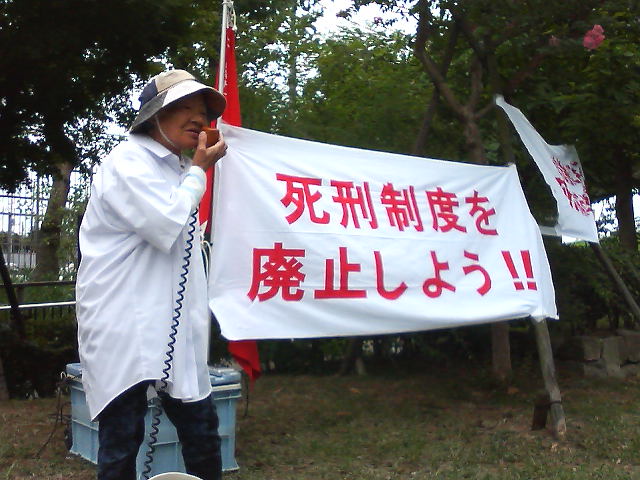The recent opening of Neojaponisme and its ambitious manifesto has my mind swimming with conflict over the role of Western expats in Japan.
So I feel this was the perfect timing for me to have come across Patrick Macias’ 2nd most recent podcast entitled “Akihabara Wars.” (MP3)
Initially I thought the general theme was “Patrick takes a walk around Akihabara and meets with some of the Westerners who consider it a second home.” There’s an interesting (if really unnerving) talk with an Italian bishojo magazine publisher at an event promoting a minor idol and a brief chat with an American college student whose side job is giving tours of Akihabara while wearing a Dragonball Z costume (I remember him from his interview in Cyzo!). Finally Macias talks with someone who insists with complete self-satisfaction that the entertainment in Akihabara is a direct equivalent to Japan’s culture of “ritualized entertainment” as found in the tea ceremony and sees absolutely “nothing to worry about” regarding the mass commercialization of otaku culture and overdevelopment of the Akihabara area because “it will go somewhere else.”
The arguments and attitude sounded somewhat familiar, but it was not until I actually checked Macias’ “Mind of Godzilla” blog for more info (I subscribe to the podcast via a fairly low-tech podcast aggregator) that I found the nerdy voice belonged to none other than longtime Japan commentator Alex Kerr.
As is usual for Macias, he mixes light material with a more serious look at his subject matter. He has turned off comments for this post, which I understand as comments like the one I want to offer would be a major buzzkill to his main audience. But I will offer it anyway because the meeting has insights not just on Kerr’s or Macias’ views or even Akihabara but on the differences among expat commentators on Japan.
I’d love to transcribe what I heard, but it is difficult for me to really get any free time these days. Please please go listen for yourself.
Reactions:
- He sounds like a completely different person in English – Despite having met Kerr before and listening to him speak in Japanese for more than an hour, I did not even recognize it was Kerr being interviewed until I checked Macias’ site As I wrote before, in Japanese he has the mannerisms of Pvt. Charles Jenkins. But in English he sounds a lot like a nerdy college student (which is who I thought Macias was talking to until I checked).
- When speaking on the fly and not from his prepared Dogs and Demons speech, Kerr’s views on Japan seem amazingly half-formed, almost as if he can barely be bothered except for the areas of Japan that he is he says he is actually worried about “saving.” When Macias offers up the arguments that otaku culture a) was originally a niche market for Japan’s true outcasts but has now been adopted by the cool people (media aimed at the mainstream and even the Japanese government) for their own ends; and b) The intense passion otaku have for their hobbies can partly be explained as an outlet for dissatisfaction with the status quo, Kerr seems unwilling to really consider them and basically repeats his interpretation of maid cafes and other otaku culture as “ritualized” entertainment. I don’t think he really understands otaku culture and hasn’t really thought about how it fits in with his view of Japan except to dismiss it as part of the unhealthy condition of the Japanese soul.
- In Kerr’s mind, the fact that the streets of Akihabara do not look all that different from a typical street in Japan seem to disqualify it from any meaningful recognition. If it doesn’t look like a row of machiya then why bother?
- What is it that allows people like Macias to so easily connect with Japanese people and culture on a human level, and what makes that same feat equally difficult for people like Kerr? Ironically, Kerr is fluent in Japanese while Macias is only decent. This problem I suspect is partly generational – much like Steven Segal who railed against uncouth young yakuza in his Into the Sun – Kerr is probably just stuck in his ways and while he might be somewhat hostile to otaku culture he seemed totally at ease and genuinely concerned when I saw him condemn concrete rivers to a crowd of obasan in Bangkok. I’ll probably be like that when I get older too – I already think Pokemon is far inferior to Power Rangers.
As I mentioned, listening to them talk was fascinating not just for the issues they discussed but because of who they are – both of them are making their livings as interpreters of Japanese culture but have gone about it in wildly different ways. Kerr presents himself as someone completely immersed in Japanese culture, a “more Japanese than the Japanese” campaigner for a return to traditional aesthetics. On the other hand, Macias keeps a lot of cultural distance because he works on reaching an American audience. The discussion makes me wonder if the two extremes I see in these people – get to close to the culture and it changes you, keep too much distance and you miss the details – are really mutually exclusive.



![日比谷公園音楽堂[拡大画像]を開く](http://www.ndl.go.jp/scenery/images/M/40007751/00000/0006_2.jpg)
